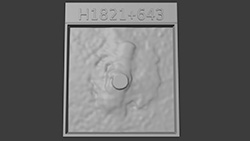CXC Home | Search | Help | Image Use Policy | Latest Images | Privacy | Accessibility | Glossary | Q&A
1
X-ray & Radio Images of H1821+643Credit: X-ray: NASA/CXC/Univ. of Nottingham/H. Russell et al.; Radio: NSF/NRAO/VLA; Image Processing: NASA/CXC/SAO/N. Wolk
In the center of these images is the quasar H1821+643, a rapidly growing supermassive black hole that astronomers have found is underachieving, despite producing intense radiation and a jet of particles seen in radio data from the Very Large Array.
Located in the middle of a cluster of galaxies, H1821+643 is surrounded by huge quantities of hot gas detected in X-rays by Chandra. The high temperatures and densities of the hot gas around the quasar shows that the black hole is having a weaker impact on its host galaxy than many of its other counterparts in other galaxy clusters. H1821+643 is the closest quasar to Earth in a cluster of galaxies. It is located 3.4 billion light-years from Earth and the image is about a million light-years across at the distance of the quasar.
Located in the middle of a cluster of galaxies, H1821+643 is surrounded by huge quantities of hot gas detected in X-rays by Chandra. The high temperatures and densities of the hot gas around the quasar shows that the black hole is having a weaker impact on its host galaxy than many of its other counterparts in other galaxy clusters. H1821+643 is the closest quasar to Earth in a cluster of galaxies. It is located 3.4 billion light-years from Earth and the image is about a million light-years across at the distance of the quasar.
2
3D Printable Files: H1821+643(3D Print Credit: NASA/CXC/A. Jubett, using software by Tactile Universe/N. Bonne & C. Krawczyk & Blender)
This tactile plate of H1821+643 is a physical relief map based on the intensity of X-ray and radio data, depicting a quasar, a rare and extreme class of supermassive black hole. H1821+643 is located about 3.4 billion light-years from Earth.
At the center of the image is a raised, circular X-ray plateau, similar to a large button ready to be pressed. A less-distinct, bar-shaped structure of radio data, slightly larger than the width of the X-ray plateau, surrounds this circular structure. The radio bar also extends above and below the X-ray button, stretching in a somewhat straight line from about the one o'clock position to the seven o'clock position on a clock face.
On either side of the radio bar, more X-ray data is present as rippling, wispy clouds of hot gas that are raised higher closer to the central features. The more bumpy clouds represent more dense gas.
At the center of the image is a raised, circular X-ray plateau, similar to a large button ready to be pressed. A less-distinct, bar-shaped structure of radio data, slightly larger than the width of the X-ray plateau, surrounds this circular structure. The radio bar also extends above and below the X-ray button, stretching in a somewhat straight line from about the one o'clock position to the seven o'clock position on a clock face.
On either side of the radio bar, more X-ray data is present as rippling, wispy clouds of hot gas that are raised higher closer to the central features. The more bumpy clouds represent more dense gas.
Return to: NASA's Chandra Identifies an Underachieving Black Hole (March 21, 2024)






